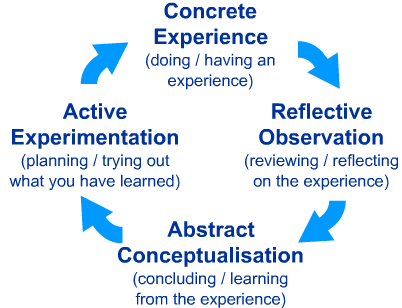Learn From Experience – Fast and Deep
How well we learn from experience determines how far we go in our careers and personal relationships. Experiential learning is so basic we take it for granted but it is a complex cognitive process that requires many different skills. Fortunately, we can get better at it, much better at it.
 Learning from experience is a four-step process that repeats. The diagram to the right is based on David Kolb’s theory of experiential learning and illustrates the steps and some of the basic skills involved. What can we learn using this process? Nearly everything it turns out. How to get along with a difficult boss, how to make money on the internet, how to loose weight, how to be happy in retirement and any other worthwhile goal that involves trial and error.
Learning from experience is a four-step process that repeats. The diagram to the right is based on David Kolb’s theory of experiential learning and illustrates the steps and some of the basic skills involved. What can we learn using this process? Nearly everything it turns out. How to get along with a difficult boss, how to make money on the internet, how to loose weight, how to be happy in retirement and any other worthwhile goal that involves trial and error.
The key is try something (concrete experience), observe the effects (reflective observation), draw conclusions (abstract conceptualization), modify your approach (active experimentation) and try again (concrete experience). Often it takes many cycles or attempts to learn something from experience.
Learning from experience is hard to do well. Major challenges include:
- Lack of the skills needed to move through one of the key steps in the process
- Overemphasizing one or two of the key steps
- Giving up too soon or not completing enough cycles for deep learning
- Not moving through the necessary cycles fast enough or cost-effectively
- Not managing it as a process or just “letting it happen”.
Each of these challenges can be met but it takes considerable time and effort. Improving your capacity to learn from experience pays lifelong dividends but like improving critical reasoning or emotional intelligence, requires a considerable investment. Given this, it will be a frequent topic on the Next Brain blog.
A great way to get started is to begin to explicitly manage the process and to learn more about your particular approach to experiential learning.
You can start to manage your experiential learning process by journaling. Focus on a specific goal, something you are already in the process of trying to learn. Keep notes on what you are hypothesizing, testing, trying and observing as you move through the process. The simple act of recording the process in writing and diagrams automatically brings structure and insight. Sometimes just asking the question – What am I actively trying to learn from experience at work and home? – can produce improvements.
 You can use Kolb’s Learning Style Inventory to understand more about your approach, strengths and weakness across the four steps int the process. You answer 13 questions and need to do some simple math and graphing but it is a scientifically validated instrument. It tells you about your style and provides practical advice on how to improve. You can buy a packet of 10 assessments from the Hay Group for $125. A bit pricey but if you are working with a group that is interested in improving learning from experience it is well worth the money. Working in a small group will have many other advantages. I don’t think anyone sells a single copy of the Learning Style Inventory but I did find, Using Kolb’s Learning Style Inventory, at the University of Georgia. This is a 7MG PDF file with a scanned copy of an older version.
You can use Kolb’s Learning Style Inventory to understand more about your approach, strengths and weakness across the four steps int the process. You answer 13 questions and need to do some simple math and graphing but it is a scientifically validated instrument. It tells you about your style and provides practical advice on how to improve. You can buy a packet of 10 assessments from the Hay Group for $125. A bit pricey but if you are working with a group that is interested in improving learning from experience it is well worth the money. Working in a small group will have many other advantages. I don’t think anyone sells a single copy of the Learning Style Inventory but I did find, Using Kolb’s Learning Style Inventory, at the University of Georgia. This is a 7MG PDF file with a scanned copy of an older version.
If you try your hand at journaling, complete the Learning Style Inventory or have other insights into how to get starting in improving experiential learning, please post a comment.
Sources:
Image of learning from experience cycle
Image of Learning Style Inventory
Categories: Memory and Learning Tags: experiential learning, Learning Style Inventory
